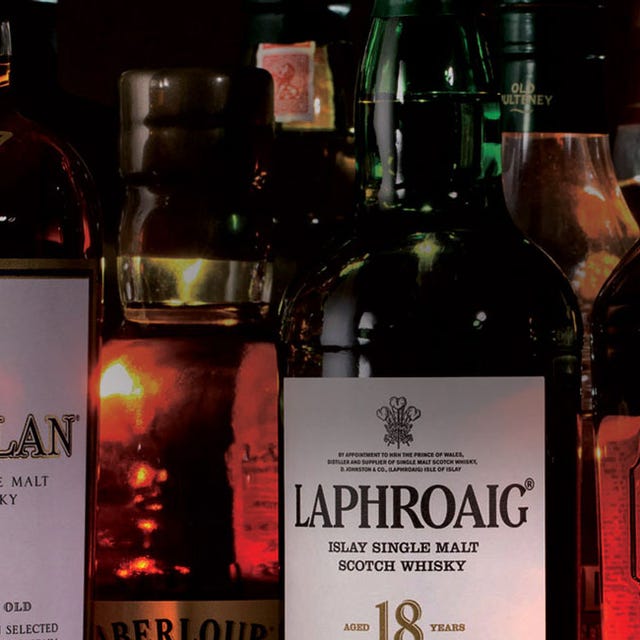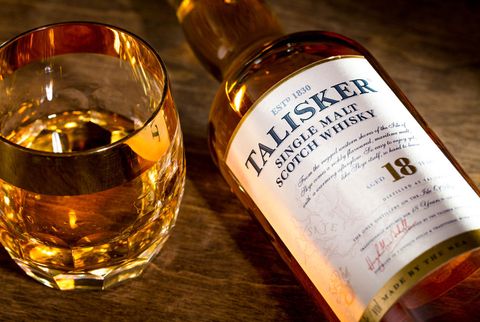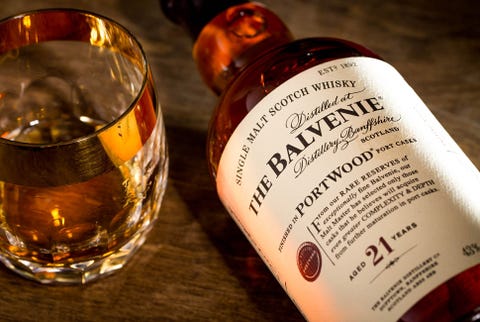Not long ago, I tasted a single malt Scotch that was well over 30 years old at the time. The shape of the bottle, the label, the cap, everything on the outside was carefully planned by marketing teams. Even the name on the side, once a small independent distillery, changed hands as parent company merged with parent company over the years. But none of this changed the fact that the Scotch itself was made by a handful of guys in the early 1980s, distilling for a company that had already been in operation for well over 100 years. Then somehow, through transfers of ownership, handshakes, publicity stunts, bad weather, recessions and leaky casks, that liquid managed to survive, unblended and unbottled, through the Cold War and into the digital age. Just to be enjoyed for a few moments.
What I tasted in those few moments were decisions made decades before, predictions made by skilled distillers. There are events in life that represent this same planning, and that are often celebrated with a single malt. Relationships that turn to marriages that turn to families. College degrees that turn to lifelong careers that turn to retirements. Or maybe, just finally getting to the end of a particularly bad day and putting your feet up, alone and comfortable.
Below is a list of premium single malts, designed as a sequel to our list of affordable single malts, which can be found here. Prices for these bottles vary widely depending on where you are, but most fall into the range of $100 to $250, and are meant to represent putting off instant gratification for the long haul, for that glass of Scotch 40 years later. And to help you understand what makes these single malts so spectacular, we spoke with an expert who has made a living drinking and thinking about that very question.
The Scotch Expert: Charles MacLean has written 10 books on Scotch whisky, including two, Scotch Whisky and Malt Whisky, that were short-listed for Glenfiddich Awards.
What Factors Play Into a “Premium” Scotch?
MacLean: Time. This has been described as “the sixth ingredient,” along with malt, yeast, water, process and wood. Scotland’s cool, damp climate permits lengthy maturation, which develops depth and complexity of flavor — assuming the cask is right. There is no substitute for this, and although warmer climates — Kentucky, India, Taiwan — produce excellent whiskies, they are, necessarily, bottled younger. Craft. The long and romantic history of Scotch adds value to the product. When you buy a bottle of Scotch, you buy a helluva lot more than liquor in a bottle. You’re buying history and tradition, craft and experience, the blood of one small nation. Marketing. You might add to the point above: “…which has been promoted through thick and thin for a very long time.” Fashion. This comes and goes. Scotch is cool, then it’s Dad’s drink again.
Over $100
Talisker 18 Year Old
Reliable Peat: Talisker is the only distillery on the Isle of Skye, and its 18-year expression falls smack in the middle of its age statement lineup. This bottle is difficult to get, but is worth the search — it took home World’s Best Single Malt Whiskey at the 2007 World Whiskey Awards.
Notes: Peat on the nose, with light citrus, brine and smokey sweetness on the tongue. A surprise favorite.
Alternative: To keep the same taste profile and take a big step down in cost and up in availability, look for Talisker 57° North.
Aberlour 18 Year Old
Most Easy-Drinking: Earlier this year, the A’bunadh — also from Aberlour in Speyside — was one of our favorites. The 18 continues this tradition by giving up the cask-strength burn for more complexity.
Notes: Sharp fruity spice, oak and lemon zest at first, then smoothing into hints of toffee and caramel that quickly fade.
Alternative: Harder to find, but worth the search, Aberlour 12 Non Chill Filtered is a highly sought-after expression.
Lagavulin 12 Year Old (2014 Special Release)
Best 12 Year: Lagavulin needs no introduction. Classic bottle, light and bright Scotch, distinct, fantastic taste.
Notes: The cask strength slaps you with butter, smoke and fruit on the nose and cracked peppercorn, citrus and peaty smoke on the tongue.
Alternative: For another good cask-strength bottle, the Glendronach Cask Strength Batch #2 is a bit cheaper and very special, if less nuanced.
Laphroaig 18 Year Old
Complex Peat: We included the Laphroaig Cask Strength and Quarter Cask in our last roundup. This offering, at 48% ABV, gives up the burn of the Cask Strength for a much more mellow finish while preserving the punishing peatiness.
Notes: Smoke that expands in your mouth, although more nuanced than you’d expect from Laphroaig, with what one taster called a “big daddy finish.” Where Lagavulin brings the pepper, Laphroaig leans on fresh pine.
Alternative: The Ardbeg Corryvreckan is another refined peat bomb at a slightly cheaper price.
Scotch’s Last Years
Many premium whiskies are 18 or 21 years old. To give a specific example, compare the Laphroaig 10 and Laphroaig 18. What exactly is happening from age 10 until age 18? What flavors are developing?
MacLean: The flavors derived from maturation — mellowness, complexity, depth, character, etc. — come from from chemical changes in the liquid, owing to oxidation, the development of acetals (I’m told), and from the individual casks. In relation to your Laphroaig example, the smoky/medicinal phenols tend to fade with lengthy maturation, so if you want a full-blooded Islay character, buy young. One is not necessarily “better” than the other.
Over $150
Old Pulteney 21 Year Old
Nuanced, but Predictable: This 21-year-old took home the World Whisky of the Year 2012 designation from Jim Murray, one of the most notable awards in the whiskey world.
Notes: Despite this, when tasted alongside the others, some said the Pulteney felt out of balance, with a large reliance on a malty, molasses backbone, oak, vanilla and citrus seeming to fight each other rather than blending.
Alternative: To trade in some of the malt for a bit more peat and brine, reach for Highland Park 21.
Highland Park 18 Year Old
Crowd Pleaser: Highland Park continues to produce great Scotch (Jim Murray loved their recent Loki release), and the 18 is no exception. It sits near the top of Distiller’s list for a reason.
Notes: Honey, chocolate and dark fruit on the nose, bright peat and allspice on the tongue, finishing with sweetness that keeps giving. Delicious and drinkable.
Alternative: Glenfarclas 25 Year Old for a bit more sherry.
BenRiach 25 Year Old Authenticus Peated
Fighting Sweet and Peat: BenRiach is known for keeping with the Speyside tradition of focusing on fruit, malt and honey rather than peat, so the Authenticus is a changeup.
Notes: It leads with dark fruit, smoke and caramel before exploding into a distinct and bright peatiness. Turning the volume up on both flavor profiles meant this was a love-it-or-hate-it kind of Scotch.
Alternative: The newly released Benromach 15 Year is another great, slightly peated Speyside.
Is There An Upper Limit to Aging?
MacLean: In the 1970s, the few malts that were bottled as single were released at 8-10 years old. Then, as mature stocks were available, at 12 years old, or even older. The owner of The Glenlivet distillery spoke to me in the early 1970s about “the tyranny of 12” which he thought was too old… But, you see, with the depletion of stock during WWII, combined with the fact that all the malt whisky made went into blends, his generation rarely tasted long-matured malt whisky. The excessive production levels by the late 1970s, combined with a change in fashion and demand for blended Scotch, led to the “Whisky Loch.” We have been benefiting from this ever since — whiskies aged 30-40 years. But in terms of flavor, these long-aged whiskies can be glorious (see above), but they can also be flat, woody, tannic, bitter. It all depends on the cask(s).
Over $200
The Balvenie 21 Year Old PortWood Finish
Best in Port: It’s tough to go wrong with The Balvenie if you like Speyside flavors. This one is very delicate and easy to drink.
Notes: A little smoke and vanilla on the nose and more malt on the tongue than the others on this list. More oak, raisins and citrus creep up at the end.
Alternative: The Balvenie DoubleWood is another quality bottle for at a bit of a cheaper price.
Bruichladdich Octomore 06.1 5 Year Old
Best Five Year Old: The Octomore, brainchild of Jim McEwan, an inductee to the Whisky Magazine Hall of Fame, is among the most expensive and by far the youngest Scotch on this list. It’s a strange, powerful beast, coming in at 167 parts per million phenol barley, a measure of peatiness; Laphroaig and Ardbeg usually come in at between 40 and 60 ppm.
Notes: Young whisky, vanilla and marshmallow on the nose, then a lot of lemon and brine on the tongue that explodes into the most peat you’ll find in a bottle.
Alternative: Octomore 6.2 maintains the peat but adds in fruit flavors with a brandy finish.
Glenfiddich 21 Year Old Gran Reserva
Only 40% ABV: This is a good choice as a gift for someone who may not be a big Scotch fan. It’s the only bottle on this list that clocks in at 40% ABV, and its wateriness is noticeable. But subtlety isn’t always a bad thing.
Notes: Smooth and quiet on the nose with allspice, vanilla and cinnamon. On the tongue it’s oaky, very sweet with a little caramel and brown sugar from its rum cask aging showing through.
Alternative: The Balvenie 14 Year Old Caribbean Cask is one of our favorites for a rum finish, at half the cost.
The Macallan 18 Year Old Sherry Oak
The Well Known: Along with Glenfiddich and The Glenlivet, The Macallan is the most recognizable name in Scotch. In early 2014, a six-liter Lalique decanter of Macallan M Imperiale sold for $628,000 at auction in Hong Kong. This sale broke the previous record for most expensive whisky ever sold at auction — a record also held by The Macallan. Interestingly, the distillery’s core line is aged in sherry casks, and this Macallan 18 is no different.
Notes: Vanilla and cherry on the nose, and a tinge of smoke, cinnamon and red apple on the tongue. Dark fruit and oak come through at the finish, making for an easy drinking Scotch with depth and character.
Alternative: Nearly impossible to find, but the Ardbog is another great sherry bomb.
Glenmorangie Signet
Chocolate and Oak: Signet has medalled at the World Whiskey Awards in four of the last five years, including Best Highland Scotch in 2011. This juice is over 30 years old, back from when Glenmorangie still did their malting on site. It was one of the best we tasted.
Notes: This is a very strange Scotch, including the use of chocolate malt and virgin barrels for aging, lending a lot of oak and cocoa, two flavors absent from the majority of Highland offerings. There’s also ginger, lots of vanilla and some citrus and dark fruit. Surprisingly smooth and nuanced for the risks taken.
Alternative: In America, Westland’s single malt also uses virgin oak barrels and chocolate malt.
Rare Releases
Should drinkers look to the rare releases, like Ardbeg Supernova, released in 2014? Does the quality justify the cost? For instance, there were concerns about Ardbeg’s 2015 release, Perpetuum. It sometimes feels as if some yearly releases happen because the distillery wants to increase sales.
MacLean: Yes. Understandably, from a commercial perspective the whisky industry — like all others — takes the view that products are worth what people are prepared to pay for them. Market forces include not only consumers but collectors and investors. In my view this can lead to some callous marketing decisions, in relation to flavor. If one brand (no names!) takes off in one market, the brand owner seeks to meet the demand or profit by it in various ways — increase the price, take off the age statement (so younger filling can be used in the mix, and the increasingly shrinking older whiskies may be used to the best advantage), limit the edition, or release annual editions to make them more collectable…But flavor is in the nose and taste of the beholder. NAS [No Age Statement] whiskies are not necessarily worse. I was not very impressed by Ardbeg Supernova, but I loved Perpetuum…
This guide is a part of a series. View our more affordable single malt Scotch whisky selections in our post entitled “10 Best Affordable Single Malts“.






























